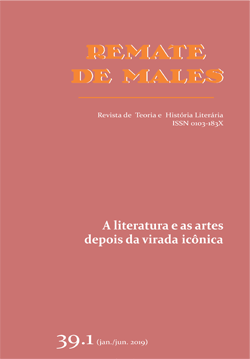Abstract
The text initially presents Paul Valéry’s critique of museums, noted in his 1923 article “Le problème des musées”, which started from a presupposition that Benjamin later theorized within the concept of “aura”. Marcel Mauss and Bataille are introduced from the point of view of their importance to think the “ethnological turn” of our vision of art and museum, which shook the aesthetic Eurocentric tradition. With Foucault the museum is thought of as one of the figures assumed by the omnipresence of heterotopias in modernity. Recovering Adorno’s reflection on museums, inspired by Valéry and Proust, the text retrieves his thesis that the arts have become inscriptions of historical suffering. The genesis of museums in the nineteenth century is resumed as part of an ontotipological ideology, of creation of the nation, of the “own” as opposed to the “other”. Then it remembers the conception of Benjamin for whom the tradition was exploded by the technical reproduction and was sucked by the cinematographic images. It concludes with the theory of Vilém Flusser of the end of the museums and the triumph of the city as total work of art, Gesamtkunstwerk. It is noted that the aestheticization of modern society can either assume a fascist character or an emancipatory character. Everything depends on the ludic-critical vision of art to be able to overcome the forces of censorship that want its annihilation and the imposition of a totalitarian thought.
References
ADORNO, Theodor W. Ästhetische theorie. Frankfurt a.M.: Suhrkamp, 1973.
ADORNO, Theodor W. Kulturkritik und Gesellschaft II. Eingriffe, Stichworte, Anhang. Gesammelte Schriften, v. 10.2. Org. por Rolf Tiedemann, com auxílio de Gretel Adorno, Susan Buck-Morss e Klaus Schulz. Frankfurt a.M.: Suhrkamp, 1977.
ADORNO, Theodor W. Teoria estética. Trad. Artur Mourão. Lisboa: Edições 70, 1982.
ADORNO, Theodor. Museu Valéry Proust. In: Prismas. Crítica cultural e sociedade. Trad. de Augustin Wernet e Jorge Almeida. São Paulo: Ática, 2001, pp. 173-185.
BATAILLE, Georges. Documents: Georges Bataille. Trad. J. C. Penna e M. J. Moraes. Desterro: Cultura e Barbárie, 2018.
BELTING, Hans. O fim da história da arte. São Paulo: Cosac e Naify, 2014.
BENJAMIN, Walter. Gesammelte Schriften. V. 1. Frankfurt a.M.: Suhrkamp, 1974.
BENJAMIN, Walter. Kapitalismus als religion. In: Gesammelte Schriften, v. VI. Frankfurt a.M.: Suhrkamp, 1991, pp. 100-102.
BENJAMIN, Walter. Magia e técnica, arte e política: ensaios sobre literatura e história da cultura. 8. ed. rev. Trad. Sérgio Paulo Rouanet; revisão técnica de Márcio Seligmann--Silva. São Paulo: Brasiliense, 2012.
BENJAMIN, Walter. A obra de arte na era de sua reprodutibilidade técnica. Org. e apres. M. Seligmann-Silva; trad. Gabriel Valladão Silva. Porto Alegre: L&PM, 2013.
CRIMP, Douglas. On the Museum’s Ruins. October, v. 13, Summer, 1980, pp. 41-57.
CUSSET, Yves. Le musée: entre ironie et communication. Paris: Pleins Feux, 2000.
FLUSSER, Vilém. Memoria. 1988. Disponível em: http://flusserbrasil.com/art292.pdf. Acesso em: 9 maio 2017.
FLUSSER, Vilém. Ensaio sobre a fotografia. Para uma filosofia da técnica. Lisboa: Relógio d’Água, 1998.
FLUSSER, Vilém. Bodenlos: uma autobiografia filosófica. São Paulo: Annablume, 2007.
FLUSSER, Vilém. O universo das imagens técnicas. Elogio da superficialidade. São Paulo: Anna Blume, 2008.
FLUSSER, Vilém. We shall survive in the memory of others. Köln: Verlag der Buchhandlung Walther König, 2010.
FLUSSER, Vilém. Pós-história: vinte instantâneos e um modo de usar. São Paulo: AnnaBlume, 2011.
FLUSSER, Vilém. A 18a Bienal de S. Paulo, exemplo de espaço-tempo novo. [s.d.1]. Disponível em: http://www.flusserbrasil.com/art62.pdf. Acesso em: 12 maio 2016.
FLUSSER, Vilém. Arte viva. [s.d.2]. Disponível em: http://www.flusserbrasil.com/art138.pdf. Acesso em: 12 maio 2016.
FLUSSER, Vilém. Como explicar a arte. Explicar a distribuição. [s.d.3]. Disponível em: http://www.flusserbrasil.com/art218.pdf. Acesso em: 12 maio 2016.
FLUSSER, Vilém. Explicar a arte. Explicar o efeito político-social. [s.d.4]. Disponível em: http://www.flusserbrasil.com/art220.pdf. Acesso em: 12 maio 2016.
FLUSSER, Vilém. O papel da arte na ruptura cultural. [s.d.5]. Disponível em: http://www.flusserbrasil.com/art435.pdf. Acesso em: 12 maio 2016.
FOUCAULT, Michel. Outros espaços. In: Estética: literatura e pintura, música e cinema (Ditos e escritos III). 2. ed. Rio de Janeiro: Forense Universitária, 2009, pp. 411-422.
HARTOG, François. Crer em história. Belo Horizonte: Autêntica, 2017.
HOLLIER, Denis. O valor de uso do impossível. In: BATAILLE, Georges. Documents: Georges Bataille. Trad. J. C. Penna e M. J. Moraes. Desterro: Cultura e Barbárie, 2018, pp. 3-35.
LÉVI-STRAUSS. Claude. Anthropologie structurale. Paris: Plon, 1958.
MAUSS, Marcel. Technique, technologie et civilisation. Ed. e pref. Nathan Schlanger. Paris: PUF, 2012.
PAPE, Elise. Postcolonial debates in Germany – an overview. African Sociological Review / Revue Africaine de Sociologie, v. 21, n. 2, 2017, pp. 2-14.
PROUST, Marcel. À sombra das moças em flor. Em busca do tempo perdido. Trad. Fernando Py. São Paulo: Ediouro, 1994.
QUINCY, Quatremère de. Lettres à Miranda sur le déplacement des monuments de l’art de l’Italie. Org. Édouard Pommier. Paris: Macula, 1989[1796].
SELIGMANN-SILVA. Márcio. Walter Benjamin e a fotografia como segunda técnica. Revista Maracanan, v. 12, n. 14, jan.-jun. 2016, pp. 58-74.
SELIGMANN-SILVA. Márcio. Physiognomia, paisagem ideal e ficção autobiográfica: a viagem à Itália de Goethe. In: O local da diferença. 2. ed. São Paulo: Editora 34, 2018, pp. 268-291.
VALÉRY, Paul. Je disais quelquefois à Stéphane Mallarmé... - Mallarmé. V. I. In: Œuvres. Paris: Gallimard, 1957, pp. 644-660; e 706-710. (Coll. Bibliothèque de la Pléiade)
VALÉRY, Paul. Le problème des musées. In: Œuvres. V. II. Paris: Gallimard, 1960, pp. 1.290-1.293. (Coll. Bibliothèque de la Pléiade)
WARBURG, Aby. Botticellis Geburt der Venus und Frühling. In: Werke. Frankfurt a.M.: Suhrkamp, 2010a[1893], pp. 39-123.
WARBURG, Aby. Dürer und die italienische Antike. In: Werke. Frankfurt a.M.: Suhrkamp, 2010b[1905], pp. 176-183.
WARBURG, Aby. Italienische Kunst und internationale astrologie im Palazzo Schifanoja zu Ferrara. In: Werke. Frankfurt a.M.: Suhrkamp, 2010c[1912/1922], pp. 373-400.
WINCKELMANN. Johann Joachim. Reflexões sobre a arte antiga. Trad. Herbert Caro e Leonardo Tochtrop. Porto Alegre: Movimento, 1975.
WINCKELMANN. Johann Joachim. Von der Nachahmung der griechischen Werke in der Malerei und Bildhauerkunst. In: WINCKELMANN, Anton Raphael Mengs; HEINSE, Wilhelm. Frühklassizismus. Helmut Pfotenhauer et al. (Org.). Frankfurt a.M.: Deutsche Klassiker Verlag, 1995, pp. 10-53.

O periódico Remate de Males utiliza a licença do Creative Commons (CC), preservando assim, a integridade dos artigos em ambiente de acesso aberto.


